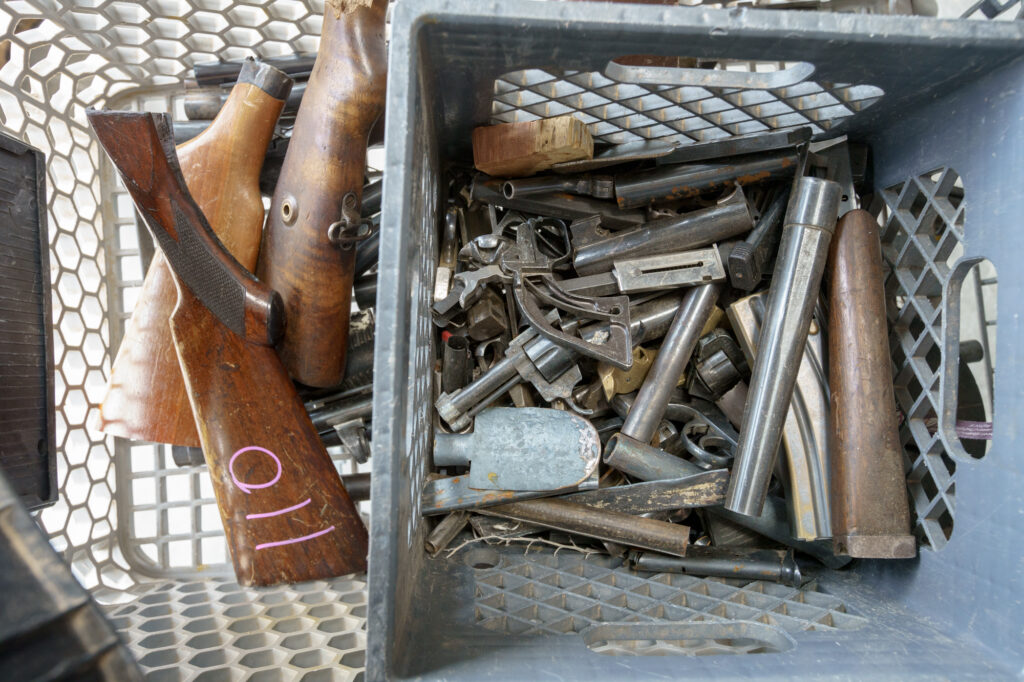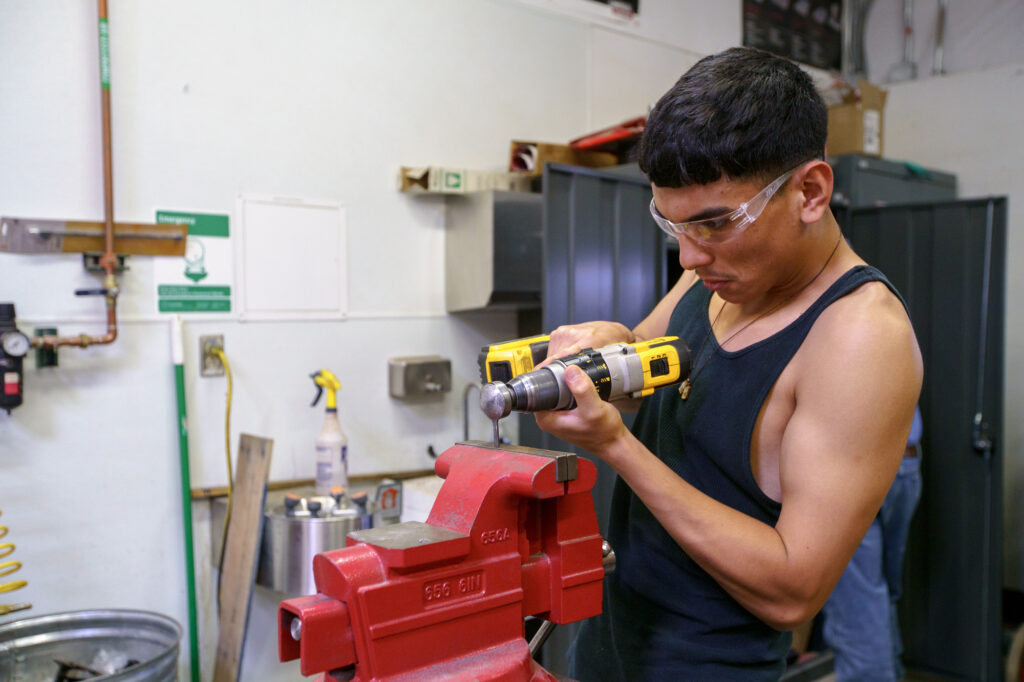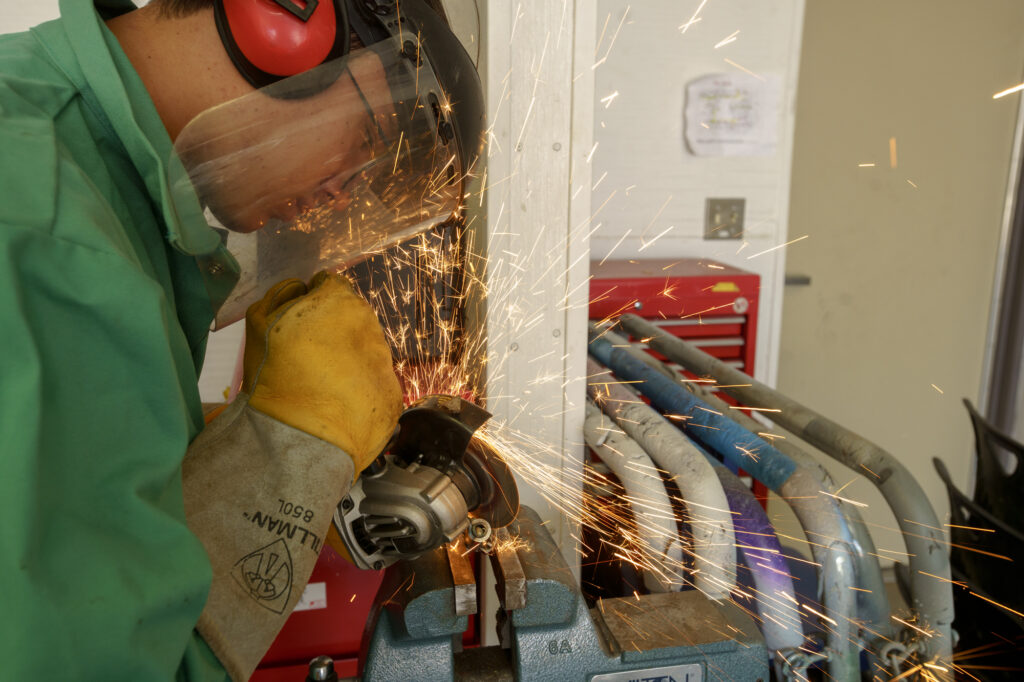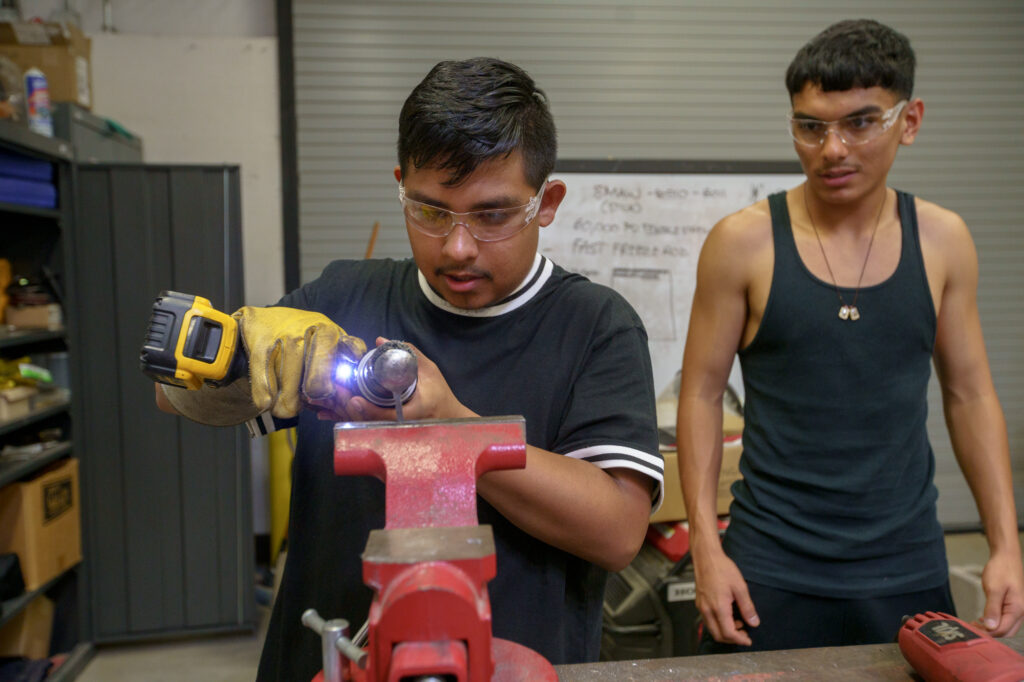Gun violence has taken a heavy toll on Albuquerque students. A school responds.
By Elise Kaplan / Searchlight NM
On a sweltering day in late June, a group of teenage boys crowded and jostled one another in a metal shop tucked behind Robert F. Kennedy Charter School in Southwest Albuquerque.
The object of their interest? A table heaped with gun barrels and firearm parts.
Almost exactly five months earlier, two of their classmates — teenage brothers — had been gunned down at a mobile home park a few miles away. It was far from the first tragedy to befall the 23-year-old middle/high school, and on this particular day it lingered in everyone’s mind.

Many of the charter school’s 375 students have a history of trauma and loss, a harsh reality that teachers and administrators are trained to recognize. School Director Robert Baade estimates that about 25 percent of the students have had a death in their family; 30 percent currently have a family member who is incarcerated; 20 percent have a family member who struggles with a substance addiction.
“It’s an at-risk population,” he said. “When somebody dies in their family what do they do? They have a car wash. They make food and take it to the family. They stand out on the corner with a sign to raise money to bury them. These families, these students, have been through this over and over. They know how to do this.”
So when, in the wake of the double homicide, RFK students wanted to release helium balloons into the sky with notes addressed to the brothers, Baade hesitated.
“All of that’s good stuff, but then it kind of fades away,” he said. “I don’t want the pain to drag around. I want the direct action about what we’re doing about it to stick around.”
He contacted Miranda Viscoli, the co-president of New Mexicans to Prevent Gun Violence, and together they hatched a plan. Five boys from the school would begin working with the nonprofit to learn how to craft vases, gardening tools, and more from firearms surrendered at buyback events.

Pedro Reyes, an internationally known Mexican artist who recently had an exhibit at Site Santa Fe, worked with the students, instructing them on how to make a 12-string guitar from gun parts. On their own they figured out how to make a xylophone — the bars crafted from rifle barrels.
Viscoli, meanwhile, had a trauma surgeon and others — including a man who was shot when he was 15 and is now in a wheelchair — come speak to the boys. She leads similar programs for schools throughout New Mexico.
“I don’t know if I’ve ever met a student who doesn’t feel like they’ve been negatively impacted (by gun violence) and we’ve worked with hundreds of students,” Viscoli said. “A lot of stress, a lot of fear, a lot of insecurity.”
The school’s staff has also seen that stress, fear and insecurity among its student body. For some, the experience of violence has made it hard for them to concentrate in class. For others, it has affected their behavior and outlook on life. Others, still, appear desensitized, already having had a drumbeat of trauma throughout their young lives.
Several boys in the forging workshop said they knew the two brothers, aged 14 and 15, who were killed in January. Others just knew of them. Guns are everywhere, they said. One boy mentioned he had a 2-year-old cousin who accidentally killed himself with a handgun that was left unattended. Another had an uncle who, he said, was incarcerated as a teenager years ago after getting into a deadly shootout.
“Most people have guns on them,” said Nathan Alvarez, 16, as he prepared to forge bolts into spoons. “They start an argument between each other for no reason, they get mad, and get their weapons out.”

He rarely goes to parties, he said, for fear of guns; he prefers to stay home or hang out with his cousins.
For Judeah Piro, 16, creating art from firearms feels like a mission.
“There would be times I would be here working and I would knock out like 10 vases if I could,” he said. “It just feels like I have to.”
A major public health problem
Research shows that proximity to violence can hamper a child’s ability to learn. A 2012 study in the American Journal of Public Health compared test scores of preschool children in Chicago before and after an act of violence in their neighborhoods. It found lower levels of impulse control, poorer attention and “lower pre-academic skills” after violent incidents.
The researchers concluded that the results “highlight the way that a major public health problem, interpersonal violence, can have consequences that spread throughout a community and affect the behavior of children living within the vicinity in which a violent incident occurs.”
Katherine Ortega Courtney, co-director of New Mexico State University’s Anna, Age Eight Institute, which focuses on child well-being, said it’s difficult to isolate the effect of violence on academic achievement. But, she said, it certainly plays a part.
“I firmly, sincerely, believe that trauma is one of the root causes of our poor education outcomes in the state,” Courtney said. “If we do not address that we’re never going to improve our educational outcomes.”

But while school shootings grab headlines, researchers say that gun violence is actually more likely to reach young people off campus — at parties, during fights or drug deals, by accident or through suicide.
That was the case in the deaths of the two brothers, who were shot one Friday night in late January. As described by their teachers, the boys were quiet and reserved, eager to learn. The younger one idolized his older brother; the two ate lunch together every day. They even dressed alike.
In a criminal complaint, detectives wrote that the pair were targeted because they were believed to have stolen a gun from another teenager.
A little more than two months after the shootings, two 17-year-old girls and a 16-year-old boy were arrested and charged with two counts of first-degree murder. According to Bernalillo County Sheriff deputies, the three teenagers asked to meet up with the brothers to “get an eighth,” but shot them instead. The older brother died at the scene. The younger was able to call 911 for help and was taken to a hospital where he died three days later.
“Most young people who die from guns actually die in communities and homes,” said Jagdish Khubchandani, a professor of public health at NMSU, whose research has identified a national increase in gun violence among juveniles from 2010 through 2019. “Sometimes we lose sight of that when we look at a school shooting and we are charged and emotional about the young people’s death.”
When Khubchandani came to the United States from India 15 years ago, he was struck by the high number of gun deaths — particularly among juveniles. He said in his home country it is very unusual for a child to be killed by a gun; it is rare for a civilian to own a firearm. Among industrialized nations, he said, 9 out of 10 gun deaths in children under the age of 15 occur in the United States.
In New Mexico, Khubchandani found that juvenile gun deaths rose 45 percent between 2010 and 2019; he doesn’t see any signs of them decreasing in more recent years.
During the 2022-23 school year, 17 guns were found in Albuquerque public and charter schools, according to a district spokeswoman. Nine of the city’s 121 homicide victims last year were teenagers, according to Albuquerque Police, while 27 of the 302 people who were shot and injured were under 18. This year, the number of minors injured in shootings has increased: To date, 31 of the 182 people shot — but not killed — were under 18.
In the unincorporated areas of the county patrolled by the Bernalillo County Sheriff’s Office, two of the seven people killed so far this year were teenagers. In fact, they were the brothers who attended RFK.
“So quiet, so polite”
Within hours of the Friday night shootings, the news began to spread.
Kristy Fernandez, who teaches English Language Arts, said she started hearing from her students on Saturday.
“They couldn’t understand how something like this would happen to students who were so quiet, so polite,” she said. “They just couldn’t believe it.”
In the days that followed, classes were frequently disrupted. Students stepped out to collect themselves — some to speak with an on-site, bilingual, five-person behavioral health team.
The incident hit Fernandez and her close friend and fellow teacher, Bernadette Arellano, hard as well, and they went home early that first day back in school, finding it too difficult to put on a brave face.
“Grief kind of ebbs and flows and so some days were really good days and other days we struggled,” Fernandez said.
For some students, seeing reminders of the brothers — a notebook left on the shelf, an empty chair — was painful; for others it was worse to have the reminders removed. Fernandez said there were days when it seemed like the teenagers wanted to vent, so she would step back from the curriculum and follow their lead.
“They might not know how to diagram sentences as well as we had hoped but I hope that on the flip side they learned about how to handle real-life situations,” she said.

Rumors, fears and extra security
Months passed before the three suspects were arrested in the slaying of the brothers. The rumor mill began immediately. And while some students grieved for their classmates and friends, others worried about their own safety and feared retaliation.
“There are neighborhood affiliations,” Baade acknowledged. “There are students here from that other neighborhood and so they knew the other kids. We knew it wasn’t going to take very long for everybody to know who did it.”
The school requested police protection from the Albuquerque Public School district and a security guard was posted at the entrance for several days. At least one parent pulled a student out of school, worried that the child could be targeted for having something to do with the incident.
“That kid who’s afraid is also traumatized,” Baade said. “It’s not like they did the killing, but it’s their cousin and now this student hates that other student.”

Fernandez, for her part, saw the changes in her classes. Her advisory period — in which students are encouraged to share their experiences and express their feelings — never regained its footing, she said. No matter how they rearranged the chairs, it was painfully obvious that someone was missing.
One girl, in particular, was “kind of like a different person afterwards.”
“She was more withdrawn, she was quiet, she had a hard time processing her feelings,” Fernandez recalled. “Whereas before it happened, she was more outgoing. She was more willing to participate in class discussions. I describe it as she kind of lost a piece of who she was.”

Elise Kaplan
Elise Kaplan moved to New Mexico in 2010 and was instantly enamored with the landscape, the people and the stories the state holds. She graduated from the University of New Mexico with a degree in journalism… More by Elise Kaplan